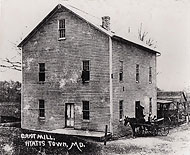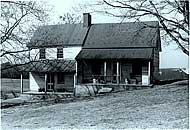
The Hyattstown Mill, located in historic Hyattstown, Maryland, was renovated by the Maryland National Capital Park and Planning Commission and Montgomery County Governent in 1997. HMAP was established in 1999 as a nonprofit cultural arts organization and entered into an agreement with the commission for use of the property as a cultural resource for the community. The mill site includes 2.3 acres surrounding two historic buildings and is located within the boundaries of Little Bennett Regional Park.
The mill at Hyattstown was built in 1798. At the time of the town’s founding,the miller was George Wolfe, Sr., who had taken over the mill when William Richards died, Mr. Wolfe purchased the mill site in 1807 and sold the property to Benjamin Waters and Frederick Baker for $5,000. In 1814, Baker operated the mill until 1872 when he sold it to Ortho Norris and wife, Sarah. They sold the property to William Farrer, who made substantial improvements to the mill over the next five years. It was a two-run flour mill and sawmill, with one employee and an output of 6,000 bushels of meal and 35,000 feet of lumber annually, valued at $4,125.00
In 1858 William Farrer advertised the property for sell. The published advertisement in the Montgomery Sentinel on October 8, 1858 lists a re-built mill with new buhrs, and a group of connected buildings, twenty-five acres of land, with a large, frame welling house, one small dwelling house, one flouring mill, two pair of four feet buhr, new, and the latest improvements for a merchant mill. One country mill, one pair of three feet seven inch buhrs all new machinery, one sawmill connected with the merchant and country mills.

The term “merchant” or “flouring” mills refers to two runs of stone usually reserved for grinding of wheat. While the country mill would be ordinarily used for custom grinding or grinding corn, apparently all housed in one building.
George A. Darby purchased the mill site in 1872, for $2901.00. The 1880 census lists Darby as the owner, with one assistant. He operated the mill until 1905, then sold to John W. Harris. Harris made improvements by installing a new roller mill, adding a steam boiler and engine and an inside and outside corn shelter beneath a shed roof. Charles Basil Murphy served as miller when Harris owned the mill. He sold to Bradley Hill Dudrow in 1991 , who purchased it as an investment. He sold in 1912, to Mortimer and Luhn. Ruth Mortimer Price recalls playing in the bran piles beside the mill. In 1914 Charles Russell Murphy began grinding for Frank Mortimer and Charles Luhn. Mortimer had experience as a machinist (mechanical engineer) with Baldwin Locomotive Co, Philadelphia. Luhn was a carriage maker, cabinet maker and wheelwright. Both did their work while financing the milling operation making the mill a small-scale industrial park. The mill handled grinding of some grains and cereals. Winter wheat and yellow and white corn were the principal grains milled. Most of the grain was purchased outright. Some custom grinding continued. In toll grinding the miller retained 25% of the finished product as a grinding fee. The whole wheat flour, baker’s flour, and corn meal were marketed locally in neighborhood stores, transported from the mill in a truck. The mill also marketed self-rising flour, produced by milling baking powder with wheat flour. A small amount of marketing was done in the Frederick County area.

301-340-2825
Montgomery Sentinel August 29, 1918 stated “fire from overheated steam boiler consumed the building igniting corn cobs.” At the time of the fire, the mill had 1,000 barrels of wheat inside. Although a possibility, spontaneous combustion was not proven. Mortimer and Luhn had little capital. The new mill was to be built the least expensive method possible. Web Burdette supervised the construction. The community pitched in to help rebuild the mill.
The metal waterwheel was shipped to Hanover, PA for repairs. Mortimer and Luhn purchased the warehouse of Price’s Distillery, and dismantled and incorporated it in the new mill. A run of buhrstones and millworks were taken from a mill in Browningsville. During the 1920s larger mills located near the railroad totally overpowered the Hyattstown Mill. The larger mills had the capacity to produced bleached flour, the most popular type, which the smaller mills didn’t handle. Mortimer and Luhm sold to Theodore Lenivitz in 1928. Although the property passed through many hands during the ensuing decades of the twentieth century the mill continued operating. The National Capital Park and Planning Commission acquired the mill for use as a park about 1970.
Links to History
- Rural Montgomery
http://www.ruralmontgomery.org/index.htm - Heritage Tourism Alliance of Montgomery County
http://heritagemontgomery.org/ - Montgomery County Agricultural Reserve
http://www.ruralmontgomery.org/agreserve.htm - Sandy Spring Museum
http://www.sandyspringmuseum.org/ - Montgomery Preservation
http://www.montgomerypreservation.org/Resources.html